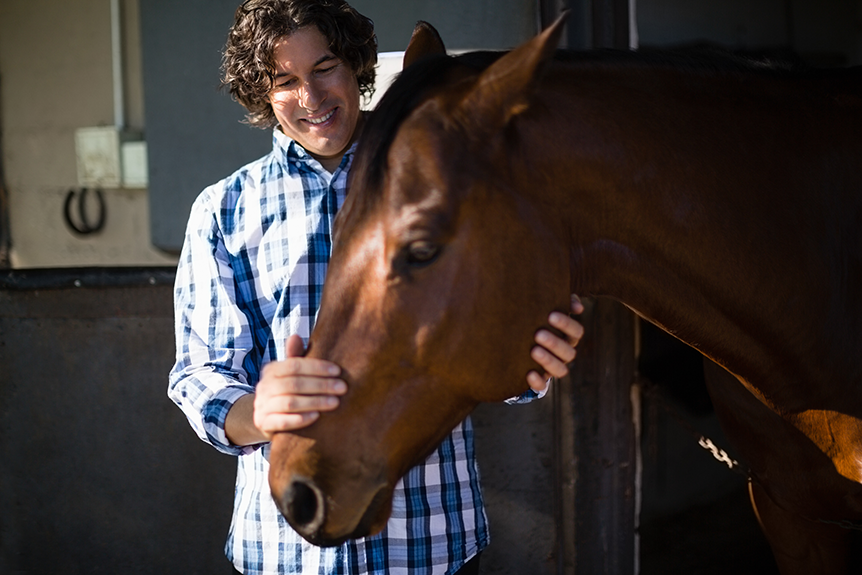To become an equine performance massage therapist, one must study equine anatomy, biomechanics, and massage techniques through an accredited educational program. Hands-on practical training is essential for developing palpation and assessment skills. Certification requires documented training hours and passing professional exams. Building real-world experience with horses enhances proficiency and confidence. Maintaining ethical practice and ongoing education is vital for career growth. Further information outlines steps from initial learning to establishing a professional presence in this specialized field.
Understanding the Role of an Equine Performance Massage Therapist

An equine performance massage therapist is a specialist trained to assess and treat musculoskeletal issues in horses, particularly those related to athletic performance, recovery, and injury prevention.
This professional applies targeted manual techniques to improve circulation, relieve muscular tension, and restore mobility. Their expertise encompasses understanding equine anatomy, gait analysis, and the specific demands placed on performance horses.
Through careful observation and palpation, they detect subtle changes in muscle tone or joint movement, which may indicate underlying strain or discomfort.
The therapist’s role also involves collaborating with veterinarians, trainers, and owners, ensuring that therapeutic interventions are safe and effective.
Much like benefits of sports massage for athletes, equine performance massage aims to support recovery, enhance performance, and prevent injuries in equine athletes.
At Spa & Massage, our philosophy of attentive care and tailored treatments mirrors the dedication required in this highly specialized field, nurturing ideal wellbeing.
Gaining Relevant Knowledge and Experience
Developing expertise as an equine performance massage therapist requires an in-depth understanding of equine anatomy, biomechanics, and common musculoskeletal conditions affecting performance horses.
At Spa & Massage, therapists recognise that hands-on experience is invaluable in refining palpation skills and interpreting subtle cues from the animal’s body.
Observing experienced practitioners, volunteering at equestrian centres, and shadowing veterinarians or trainers offer practical opportunities to build confidence and insight.
Familiarity with a horse’s musculature and gait, as well as the ability to distinguish normal from abnormal tissue responses, is fundamental.
In practice, this knowledge underpins the development of tailored massage techniques, much like the approach taken in Spa & Massage clinics, where treatments are customised according to each client’s unique requirements for ideal well-being and recovery.
Education and Certification Pathways
Pursuing a career as an equine performance massage therapist requires formal education in equine anatomy, physiology, and massage techniques, often through accredited courses designed specifically for this niche field. Candidates typically enroll in programmes that blend theoretical instruction with practical modules, guaranteeing a robust understanding of the musculoskeletal system and common equine conditions.
Certification bodies may require documented training hours, case studies, and successful completion of examinations to confer professional status. Although Spa & Massage specialises in human therapies, the same dedication to rigorous training and ongoing professional development applies.
For those in London and beyond, selecting a course with recognised accreditation ensures credibility and alignment with industry standards. Continuing education further supports mastery, reflecting Spa & Massage’s commitment to excellence and ethical practice in all therapeutic disciplines.
Building Practical Skills and Hands-On Techniques
How does one move from theoretical knowledge to true proficiency as an equine performance massage therapist? The progression requires dedicated hands-on practice under supervision.
Mastery of palpation, muscle assessment, and targeted massage strokes is achieved by working directly with horses, observing subtle feedback, and refining touch.
At Spa & Massage, therapists understand that each animal’s anatomy and temperament demand a tailored approach, much like the individualized care provided to human clients.
Practitioners are encouraged to practice on varied breeds and conditions, gradually building confidence and technical accuracy.
Regular feedback from mentors and peers is essential for improving technique and ensuring safety.
Ultimately, consistent, mindful application of learned techniques bridges the gap between classroom theory and the skillful, intuitive practice required in the field.
Establishing Your Career in Equine Performance Massage
After gaining hands-on proficiency through supervised practice, the next step is to establish a sustainable professional presence as an equine performance massage therapist. Building a reputable practice requires clear communication, reliable scheduling, and consistent delivery of high-quality, client-focused care.
Creating a professional online presence, connecting with local equestrian communities, and maintaining active engagement with veterinarians and trainers are essential strategies. Continued professional development ensures knowledge remains current and practices remain effective.
At Spa & Massage, therapists emphasise the importance of tailored consultation and follow-up care—principles that translate well to equine clients. Documenting treatment outcomes and gathering client feedback will further enhance reputation and trust.
Ultimately, a thoughtful, client-centred approach lays the foundation for a thriving, respected equine performance massage career.
Conclusion
Ultimately, pursuing a career as an equine performance massage therapist demands a fusion of scientific knowledge, skillful hands, and dedication to animal welfare. By following structured educational pathways, gaining practical experience, and committing to lifelong learning, aspiring therapists can build a robust practice. Much like a skilled mechanic tuning a race car, the equine performance massage therapist fine-tunes equine athletes, optimizing their performance and well-being in a continually evolving field.



